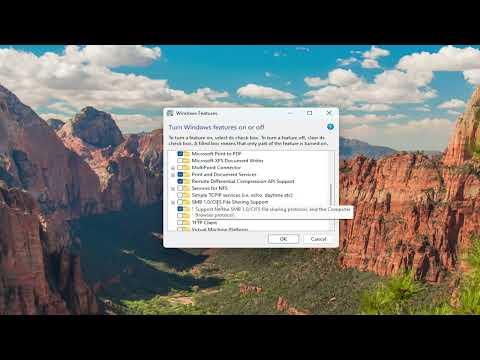I recently faced a dilemma with my Windows 11 setup, which led me down a rather unexpected path. It all started when I tried to connect to an old network drive. Despite my best efforts, the connection failed repeatedly. After some troubleshooting, it became evident that the issue was related to the SMB1 protocol.
I remember the moment vividly: I was working on an important project, needing access to files stored on a network drive that had been functioning perfectly until now. I was halfway through reviewing some crucial documents when I noticed that the drive had disappeared from my network locations. Panic set in as I realized that my access to these files was suddenly restricted.
Determined to resolve this problem, I began to investigate the root cause. After checking various aspects of my network settings and hardware, I stumbled upon the possibility that the SMB1 protocol might be the culprit. SMB1, or Server Message Block version 1, is a network file sharing protocol that allows applications to read and write to files and request services from server programs. It’s an older protocol that is often used by legacy systems.
Realizing that SMB1 could be causing the connection issues, I needed to find out how to enable or disable it on my Windows 11 system. Here’s the step-by-step process I followed, which might help anyone else facing a similar challenge.
First, I navigated to the Windows Features dialog to manage the SMB1 protocol. To do this, I clicked on the Start menu and typed “Turn Windows features on or off” into the search bar. This action opened the Windows Features window, where I could enable or disable various components of the operating system.
In the Windows Features window, I scrolled through the list until I found the “SMB 1.0/CIFS File Sharing Support” entry. This section contained a checkbox that I could check or uncheck to enable or disable SMB1. Since my issue involved enabling SMB1, I checked the box next to this option. However, I was aware of the security implications of using SMB1, as it is an outdated protocol with known vulnerabilities. Therefore, I was careful to only enable it temporarily to address my immediate need.
After selecting the checkbox, I clicked the “OK” button. Windows began to apply the changes, which involved installing the necessary components. This process took a few moments, and I patiently waited for it to complete. Once the installation was finished, I needed to restart my computer to ensure that the changes took effect.
With my system rebooted, I attempted to reconnect to the network drive. To my relief, the connection was successful, and I regained access to the files I needed. The issue seemed resolved, but I knew I had to take further steps to ensure my system remained secure.
Given the security risks associated with SMB1, I made a note to disable the protocol once I was done with my immediate task. To disable SMB1, I repeated the process of accessing the Windows Features dialog. This time, I unchecked the box next to “SMB 1.0/CIFS File Sharing Support” and clicked “OK” to apply the changes. After another restart, SMB1 was disabled, reducing the risk of potential vulnerabilities.
In addition to enabling and disabling SMB1, I also explored other security measures to safeguard my system. For instance, I reviewed my firewall settings to ensure that they were configured correctly. I also checked for any available Windows updates, as keeping my system up-to-date was crucial for maintaining security.
Throughout this process, I learned a valuable lesson about balancing functionality with security. While enabling SMB1 temporarily resolved my issue, I was reminded of the importance of using modern protocols and maintaining a secure environment. For future reference, I made a note to consider alternative solutions, such as updating network devices or using more secure file-sharing protocols.
In conclusion, dealing with the SMB1 protocol issue required a methodical approach. By navigating the Windows Features dialog to enable or disable SMB1, I managed to address my immediate problem while also taking steps to protect my system. This experience highlighted the importance of staying informed about system components and security practices, ensuring that I can handle similar challenges more effectively in the future.
